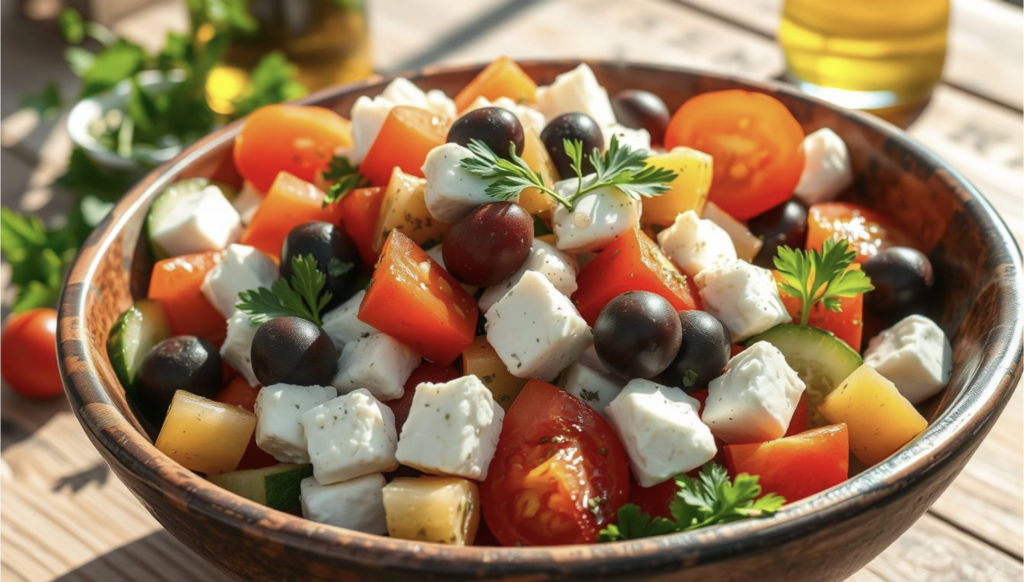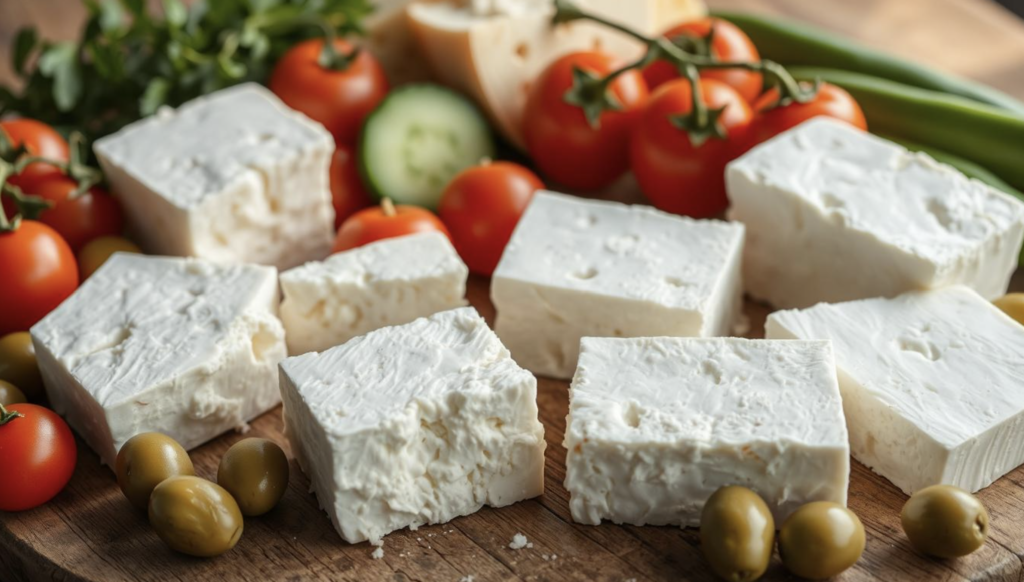The classic Greek salad is a true delight from the Mediterranean. It’s loved by food lovers everywhere. This recipe is simple yet full of flavor, making it perfect for a quick, healthy meal.

A colorful, fresh Greek salad arranged beautifully in a rustic bowl, featuring vibrant red tomatoes, crisp cucumber slices, Kalamata olives, creamy feta cheese chunks, diced bell peppers, and a sprinkle of oregano, all drizzled with golden olive oil and garnished with fresh parsley. The background is a sunlit Mediterranean table setting with a hint of rustic wooden textures.
This salad’s success comes from its fresh, quality ingredients. You’ll need juicy tomatoes, crisp cucumbers, tangy feta cheese, and briny Kalamata olives. Each adds to the salad’s perfect balance. You can make it in just 15 minutes, making it great for any day or event.
What Makes an Authentic Greek Salad Special
The classic Horiatiki salad is a favorite in traditional Greek cuisine. It’s loved by locals and food lovers around the world. Unlike modern versions, an authentic Greek salad is more than a mix of greens and toppings. It truly represents the Mediterranean diet and Greece’s rich culture.
Traditional Greek Salad vs. Modern Adaptations
What sets a traditional Horiatiki apart from modern versions is the ingredients. Modern salads may have many greens, but the real Horiatiki has simple yet tasty ingredients. These include ripe tomatoes, crisp cucumbers, pungent red onions, and briny Kalamata olives.
The star of the salad is the creamy, tangy feta cheese. It’s a key part of the dish’s identity.
The Cultural Significance of Horiatiki
The Horiatiki salad is more than just food; it’s a cultural treasure. It shows Greece’s love for fresh, local authentic ingredients. The salad’s simplicity highlights the Mediterranean diet focus on natural flavors of seasonal produce.
Sharing a Horiatiki salad is a way to celebrate Greece’s rich culinary heritage. It’s a celebration of the country’s traditions and the importance of Horiatiki in Greek daily life.
| Traditional Horiatiki Salad | Modern Salad Adaptations |
|---|---|
| Ripe tomatoesCrisp cucumbersPungent red onionsBriny Kalamata olivesCreamy, tangy feta cheese | Mixed greensVariety of vegetablesAdditional toppings (e.g., bell peppers, olives, herbs)Feta cheese may be optional or used in smaller amounts |
Essential Ingredients for Your CLASSIC GREEK SALAD
A classic Greek salad is a delightful taste of Mediterranean cuisine. It’s all about using fresh, high-quality ingredients. From juicy fresh vegetables to tangy feta cheese and briny Kalamata olives, each part is key to its flavor.
Let’s look at the essential ingredients for a Greek salad:
- Tomatoes: Choose ripe, juicy tomatoes for the base. They should be colorful and have a good balance of sweet and tangy.
- Cucumbers: Add a refreshing crunch with crisp cucumbers. Opt for small to medium-sized ones with a bright green color.
- Red Onions: Thinly sliced red onions add a pungent flavor that goes well with the other ingredients.
- Bell Peppers: Bell peppers, in a mix of colors, add a delightful crunch and a bit of sweetness.
- Feta Cheese: Tangy, creamy feta cheese is essential. Crumble it over the salad for a unique Greek flavor.
- Kalamata Olives: Briny, flavorful Kalamata olives add a savory, umami taste to the salad.
- Extra Virgin Olive Oil: A drizzle of high-quality extra virgin olive oil brings all the flavors together, enhancing taste and texture.
| Ingredient | Importance in Greek Salad |
|---|---|
| Fresh Vegetables | They provide the crunchy texture and fresh flavors. |
| Feta Cheese | It adds a tangy, creamy element that balances the salad. |
| Kalamata Olives | They add a savory, briny note that enhances the taste. |
| Extra Virgin Olive Oil | It ties all the flavors together, creating a smooth dressing. |
By choosing and using these essential ingredients, you can make a delicious classic Greek salad. It will take your taste buds on a trip to the Mediterranean.https://www.youtube.com/embed/UYePT_0l2Kc
Selecting and Preparing Fresh Vegetables
Making a real Greek salad begins with picking the freshest, tastiest veggies. You’ll need ripe tomatoes, crisp cucumbers, and bright bell peppers. Each one is key to the salad’s taste and feel.
Choosing the Perfect Tomatoes
For ripe tomatoes, look for ones that feel firm but a bit soft. Stay away from tomatoes with spots or soft areas. For the best taste, choose tomatoes that are in season and locally grown.
Cucumber and Bell Pepper Selection Tips
Crisp cucumbers and sweet bell peppers bring a cool crunch to the salad. Pick cucumbers that are firm and bright green. For bell peppers, go for ones that are full and have a shiny, deep color.
Red Onion Preparation Techniques
Mild red onions are a must in Greek salads, but they can be too strong. To soften their flavor, soak sliced onions in ice water for a few minutes. This trick balances the onion’s taste with the other ingredients.
By picking and preparing your veggies with care, you’ll make a Greek salad full of life. It will have vibrant colors, crisp textures, and the true tastes of the Mediterranean.
The Art of Choosing Quality Feta Cheese
Creating an authentic Greek salad starts with the feta cheese. This tangy, creamy sheep’s milk cheese is key. It brings a unique flavor and texture to the salad. Choosing the right Greek feta can take your salad to the next level.
For the best feta cheese in your Greek salad, choose 100% sheep’s milk options. Real Greek feta has a creamy texture and tangy flavor. These qualities enhance the salad’s fresh veggies and other ingredients.
- Opt for feta in brine or whey to keep it moist and flavorful.
- Avoid pre-crumbled feta as it can lose its texture and taste over time.
- Consider purchasing feta blocks and crumbling or cubing them yourself just before assembling the salad.
By choosing high-quality Greek feta, you’ll make a Greek salad that’s truly authentic and full of flavor. Enjoy the perfect mix of creamy texture and tangy taste in every bite.

A close-up view of a rustic wooden table displaying various blocks of traditional Greek feta cheese, surrounded by fresh ingredients like ripe tomatoes, crisp cucumbers, and vibrant green olives, with a soft sunlight illuminating the scene, showcasing the creamy texture and crumbly nature of the feta.
Kalamata Olives: The Perfect Briny Addition
No authentic Greek salad is complete without Kalamata olives. These olives come from the Peloponnese region of Greece. They have been a favorite for centuries. Their rich, earthy aroma and bold, briny taste add a delightful Mediterranean flair.
Types of Olives for Greek Salad
While Kalamata olives are the traditional choice, other varieties can also work well. Some popular alternatives include:
- Manzanilla olives: Small, green olives with a mild, buttery flavor.
- Niçoise olives: Tiny, black olives with a fruity, slightly nutty taste.
- Ligurian olives: Large, meaty olives with a slightly bitter, peppery finish.
Pitting and Preparing Olives
When preparing olives for your Greek salad, it’s important to properly pit and slice them. Start by rinsing the olives under cool water to remove any excess brine. Then, using a paring knife or olive pitter, carefully remove the pits. Finally, slice the olives in half or quarter them, depending on your preference. This will help ensure an even distribution of their robust Mediterranean flavors throughout the salad.
| Olive Variety | Flavor Profile | Best Uses |
|---|---|---|
| Kalamata | Bold, briny, and earthy | Traditional choice for Greek salads |
| Manzanilla | Mild, buttery | Complementary to the salad’s other flavors |
| Niçoise | Fruity, slightly nutty | Adds a unique twist to the classic Greek salad |
| Ligurian | Meaty, with a peppery finish | Provides a heartier texture and flavor |
Creating the Perfect Greek Salad Dressing
Making a real Greek salad dressing is key to making your homemade Horiatiki salad better. It starts with the right mix of extra virgin olive oil and red wine vinegar. These two ingredients blend to give a bold yet refreshing taste.
Dried oregano is a must for that authentic Greek flavor. You can also try adding garlic, lemon juice, or honey to make your dressing special.
| Ingredient | Quantity |
|---|---|
| Extra virgin olive oil | 1/4 cup |
| Red wine vinegar | 2 tablespoons |
| Dried oregano | 1 teaspoon |
| Garlic, minced | 1 clove |
| Honey (optional) | 1 teaspoon |
| Salt and pepper, to taste |
To make the dressing, just mix all the ingredients in a bowl until smooth. Taste and adjust the seasoning. Then, you’re all set to pour it over your Greek salad.

A close-up of a vibrant Greek salad dressing, showcasing a clear glass jar filled with a golden olive oil, fresh herbs like oregano and basil, and bright lemon slices floating on top, surrounded by colorful ingredients like ripe tomatoes, cucumbers, and red onions in the background, drizzled with balsamic vinegar for added contrast.
Step-by-Step Assembly Instructions
Making a classic Greek salad is easy and fun. It highlights the fresh, vibrant flavors of Mediterranean ingredients. Just follow these simple steps:
Layering Techniques
- Choose a sturdy, wide-rimmed serving bowl or a rustic Mediterranean-style platter for your salad.
- Start with a layer of crisp romaine lettuce or iceberg lettuce at the bottom.
- Place sliced tomatoes and cucumber on top of the lettuce, spreading them out evenly.
- Add crumbled feta cheese and pitted Kalamata olives over the veggies.
- Finish with thinly sliced red onion rings scattered over the salad.
Presentation Tips
A visually appealing Greek salad has a rustic, Mediterranean-inspired look. Aim for a casual appearance rather than a perfect arrangement. This lets the salad’s colors and textures shine.
Finally, drizzle Greek salad dressing over the salad. Let it flow down the sides of the serving bowl or platter. This adds a touch of elegance to your salad assembly.
Common Mistakes to Avoid When Making Greek Salad
Making a Greek salad, or Horiatiki, can be fun. But, it’s easy to make mistakes that can mess up the dish. One big mistake is over-mixing the salad, making it soggy. To fix this, gently toss the ingredients together.
Another mistake is swapping out key ingredients. Using the wrong tomatoes or different olives can change the salad’s taste. It’s key to use the freshest, best ingredients for the right flavors.
Also, adding too much dressing is a common error. This makes the salad soggy and too wet. The goal is to use just enough dressing to lightly coat the veggies. This lets the natural flavors of the ingredients stand out.
FAQ
What makes an authentic Greek salad special?
An authentic Greek salad, known as Horiatiki, stands out for its simplicity. It uses fresh, high-quality Mediterranean ingredients. The salad includes ripe tomatoes, crisp cucumbers, sweet bell peppers, sharp red onions, briny Kalamata olives, and creamy feta cheese.
It’s dressed with fragrant extra virgin olive oil and tangy red wine vinegar.
What are the essential ingredients for a classic Greek salad?
A classic Greek salad needs juicy tomatoes, crunchy cucumbers, vibrant bell peppers, and pungent red onions. It also includes salty Kalamata olives and tangy feta cheese.
The dressing is made with extra virgin olive oil and red wine vinegar. It’s seasoned with dried oregano.
How do I select and prepare the fresh vegetables for my Greek salad?
Choose ripe, flavorful tomatoes, crisp cucumbers, sweet bell peppers, and mild red onions. For tomatoes, pick vine-ripened ones with deep, juicy flavor.
For cucumbers and bell peppers, go for firm, vibrant ones. Soak red onions in water to mellow their sharpness before adding them to the salad.
What is the best way to choose quality feta cheese for my Greek salad?
Look for high-quality, authentic Greek feta made from sheep’s or goat’s milk. It should have a creamy, slightly crumbly texture and a tangy, salty flavor.
Avoid pre-crumbled feta. Instead, buy a block and crumble or cube it just before assembling your salad.
How do I incorporate Kalamata olives into my Greek salad?
Kalamata olives add a briny, umami-rich flavor to your salad. You can leave them whole or pit and slice them, depending on your preference.
If pitting the olives, do so carefully to preserve their shape and texture. Toss the olives with the other salad ingredients just before serving.
What is the best way to make an authentic Greek salad dressing?
Use high-quality extra virgin olive oil, tangy red wine vinegar, and dried oregano for the dressing. The olive oil to vinegar ratio is usually 3:1, but adjust to taste.
Whisk the ingredients together until emulsified. Then, drizzle the dressing over the salad just before serving.
How do I properly assemble and present my Greek salad?
Start by layering the vegetables in a rustic, Mediterranean-style serving bowl. Arrange the tomatoes first, then add the cucumbers, bell peppers, and red onions.
Sprinkle the Kalamata olives and crumbled feta cheese over the top. Drizzle the homemade Greek dressing over the salad, being careful not to over-mix.
For a beautiful presentation, garnish the salad with a sprinkle of dried oregano or a few fresh herb leaves.
What are some common mistakes to avoid when making a Greek salad?
Avoid over-mixing the salad, which can make it soggy. Use the right ingredients, like fresh olives and feta, not canned or pre-crumbled.
Don’t add too much dressing, as it can overwhelm the flavors. Also, properly prepare the vegetables, like soaking the red onions to reduce their sharpness.
To ensure a perfect Greek salad, focus on using high-quality, fresh ingredients and assembling the salad with a light touch.